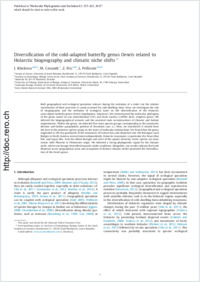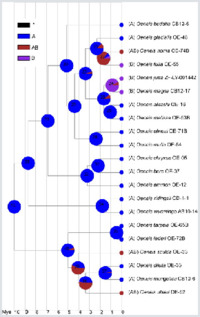Diversification of the cold-adapted butterfly genus Oeneis related to Holarctic biogeography and climatic niche shifts
- Kleckova, I. Faculty of Science, University of South Bohemia, České Budějovice, Czech Republic - Institute of Entomology, Biology Centre of the Czech Academy of Sciences, České Budějovice, Czech Republic
- Cesanek, M. Bodrocká 30, 821 07 Bratislava, Slovakia
- Fric, Z. Faculty of Science, University of South Bohemia, České Budějovice, Czech Republic - Institute of Entomology, Biology Centre of the Czech Academy of Sciences, České Budějovice, Czech Republic
- Pellissier, Loïc University of Fribourg, Department of Biology, Ecology & Evolution, Switzerland - Landscape Ecology, Institute of Terrestrial Ecosystems, ETH Zürich, Switzerland
-
09.07.2015
Published in:
- Molecular Phylogenetics and Evolution. - 2015, vol. 92, p. 255–265
English
Both geographical and ecological speciation interact during the evolution of a clade, but the relative contribution of these processes is rarely assessed for cold-dwelling biota. Here, we investigate the role of biogeography and the evolution of ecological traits on the diversification of the Holarctic arcto-alpine butterfly genus Oeneis (Lepidoptera: Satyrinae). We reconstructed the molecular phylogeny of the genus based on one mitochondrial (COI) and three nuclear (GAPDH, RpS5, wingless) genes. We inferred the biogeographical scenario and the ancestral state reconstructions of climatic and habitat requirements. Within the genus, we detected five main species groups corresponding to the taxonomic division and further paraphyletic position of Neominois (syn. n.). Next, we transferred O. aktashi from the hora to the polixenes species group on the bases of molecular relationships. We found that the genus originated in the dry grasslands of the mountains of Central Asia and dispersed over the Beringian Land Bridges to North America several times independently. Holarctic mountains, in particular the Asian Altai Mts. and Sayan Mts., host the oldest lineages and most of the species diversity. Arctic species are more recent, with Pliocene or Pleistocene origin. We detected a strong phylogenetic signal for the climatic niche, where one lineage diversified towards colder conditions. Altogether, our results indicate that both dispersal across geographical areas and occupation of distinct climatic niches promoted the diversification of the Oeneis genus.
- Faculty
- Faculté des sciences et de médecine
- Department
- Département de Biologie
- Language
-
- English
- Classification
- Biological sciences
- License
-
License undefined
- Identifiers
-
- RERO DOC 257840
- DOI 10.1016/j.ympev.2015.06.012
- Persistent URL
- https://folia.unifr.ch/unifr/documents/304580
Other files
Statistics
Document views: 106
File downloads:
- pdf: 754
- Supplementary material: 121

